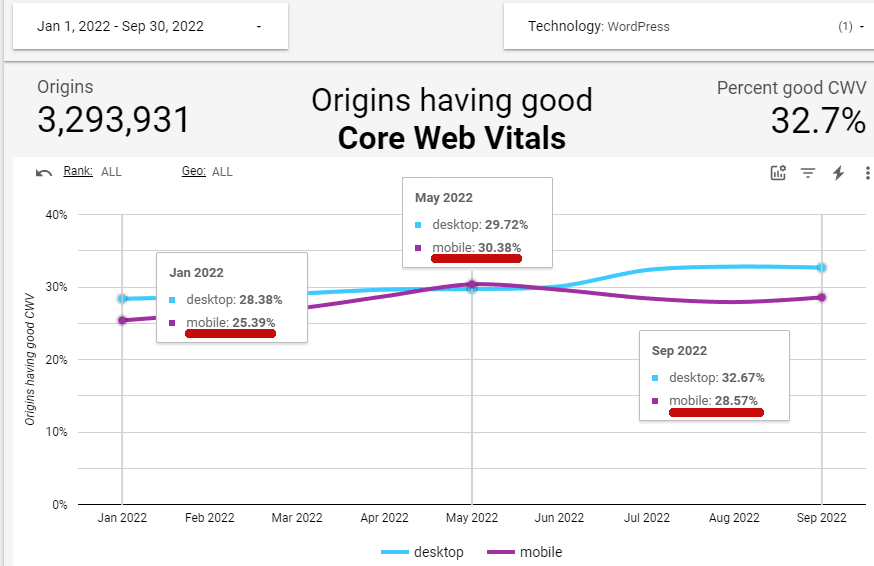
WordPress 6.1 Is Jam-Packed With Performance Upgrades
WordPress 6.1, arriving November 2022, is jam-packed with performance improvements, signaling that this may be the update that many have been waiting for.
WordPress performance scores from the beginning of 2022 until the end of September have been relatively stable, going up a few percentage points in the spring then dropping in the summer, ending September roughly 3 percentage points higher than from the start of the year.
WordPress Core Web Vitals Performance in 2022

Most other platforms have enjoyed more substantial performance improvements month after month in 2022:
- Wix up by 13 points
- Duda up by 8 points
- Squarespace up by 7 points
- Joomla up by 7 points
- Drupal up by 5 points
“Massive Improvement” To WP_Query Performance
An important performance boost is the addition of caching to WP_Query in the database.
What that means is that every time a visitor requests a webpage that request will remain in a cache, a memory of what was retrieved from the database.
When another visitor requests the same webpage, instead of making another request to the database WordPress will instead retrieve the webpage data from the cache (memory) instead of retrieving (making a query) from the database. That results in faster performance.
Improvement to REST API Database Queries
When a webpage is requested, the webpage will make different requests for various components of the page. This improvement streamlines that process by reducing the number of database queries (requests for parts of a webpage).
Additional Caching Improvements
- Improvements to Cache API
- Post, Post Types Improvements
- Multisite improvements
- Media Handling Improvement
- Improved PHP performance for Core Blocks Registration
Source: WordPress 6.1 Is Jam-Packed With Performance Upgrades
3 new YouTube streaming, shopping, and audio features

YouTube has just announced three new features for advertisers to reach people where and when they’re watching the most. The three new features are spread across shopping, audio, and streaming in what YouTube calls the YouTube Effect (the unique dynamic between YouTube creators and viewers).
Moment Blast
Moment Blast gives advertisers prime positioning on YouTube Select content on connected TVs (CTV) and other devices, plus a Branded Title Card and optional Masthead placement.
Moment Blast is intended for brands looking to raise awareness during key moments, like major sporting events, movie releases or product launches.
In the announcement, YouTube says “People have always connected in front of the TV screen, but YouTube gives them the unique chance to bond over shared passions — like watching live-streamed concerts, fitness classes or even religious ceremonies together. They feel a similar connection to the ads they get, too.” YouTube also says 59% of respondents in a survey feel that ads they see on YouTube are more relevant than on linear TV or other streaming apps.
Expanded product feeds for Discovery Ads
YouTube will be expanding product feeds to Discovery ads to help advertisers scale their social media creative and reach more engaged viewers. Soon, product feeds will also include local offers, allowing brands to show real-time availability for products in their Google Merchant Center so people can find the most convenient place to buy.
Creators will also be able to transform their content into virtual storefronts. Additionally, more creators will have the ability to tag products in their videos and Shorts.
These features will be available on November 10.
Reach music and podcast listeners
Audio ads are now globally available to buy in Google Ads and Display & Video 360. Audio ads are designed to reach people on audio surfaces and in listening-first states.
Podcast targeting is also now available globally. “With Podcast targeting, brands and agencies can specifically reach podcast listeners.”
Source: 3 new YouTube streaming, shopping, and audio features
The Pinterest Trends Tool is expanding with a new API for Conversions

The new Pinterest API for Conversions gives advertisers a full view of their campaign performance as well as actions their audience took on their site, and it will be integrated with tag management partner Google Tag Manager and commerce partner Shopify.
The Pinterest Trends Tool. Pinterest is expanding the capabilities of its Trends Tool which came out in 2019 to help advertisers worldwide gain deeper insights into the behavior of Pinterest users and to use that information in planning their campaigns.
New updates. New Trends Tool updates also announced include three new features:
- A widget on the Pinterest Trends homepage that lets advertisers see what has been trending with their engaged users and followers over the past 90 days
- Trends filtered by demographic, place, time and topic
- And new trend types, including seasonal trends, to help brands better align their content and marketing calendars with times when users are most engaged with those specific topics
Early API adopters. Pinterest also said hundreds of advertisers worldwide have already implemented the tagless, server-to-server solution, and early results included improvements of 14% in CPAs on average for optimized CPM campaigns when using both the API for Conversions and tags, compared with tags only, and a 36% average increase in attributed conversion volume under the same conditions.
Though the new API was most frequently used for lower-funnel actions such as checkouts, they are also seeing success in full-funnel actions like page visits and add to cart.
What Pinterest says.
“Pinterest is uniquely positioned at the intersection of discovery and commerce, where inspiration meets intent. We are investing across our advertising platform to help businesses around the world reach their goals and connect with leaned in consumers at every stage of the campaign lifecycle.”
Pinterest chief revenue officer Bill Watkins
Source: The Pinterest Trends Tool is expanding with a new API for Conversions
New @wordpress/data stores in WooCommerce Blocks

In WooCommerce blocks 8.7.0 we refactored a significant portion of our Cart and Checkout blocks’ code. Specifically, a lot of the data previously kept in React Contexts was moved into WordPress data stores (@wordpress/data). We did this to make it easier for third party extensions to extend the functionality of the Cart and Checkout blocks.
The changes we’ve made are all backward compatible, so any existing integrations should continue to work without any intervention.
We have added the following data stores, however, some actions and selectors on these stores are currently for internal use only while we evaluate which ones third party applications should have access to:
wc/store/payment– used to store information about the payment state and available payment methods.wc/store/validation– used to store information about validation, currently this is used in by Cart block to ensure the Shipping Calculator form is valid, and by the Checkout block to ensure the checkout form is valid. Extensions can use this data store to add validation to their own integrations.wc/store/checkout– used to store information about the checkout state (whether it’s before processing, after processing, idle, or completed), whether it has errors, or whether any calculations are pending (changes to shipping method or address will cause a “calculation” to be in progress until the request completes). It also stores whether the shipping address should be used as the billing address, the draft order number, and the order notes.
These stores are documented on GitHub. This documentation is continually being updated so please be sure to check back often.
Source: New @wordpress/data stores in WooCommerce Blocks
More News:
TikTok Planning On Opening Warehouses In U.S.